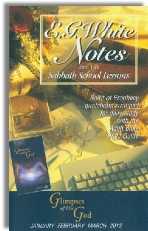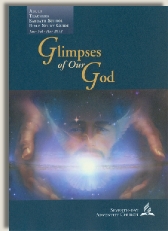|
||||||||||||||
Commentary on "Creation Care"
Day 1: Sabbath Afternoon, February 18, 2012 - Introduction
Dear reader, please take a moment to bow your head and ask Jesus to guide your study this week. Test every concept against God’s Word, and allow Him to gently override your own assumptions as necessary. –Dana
Summary
In Saturday’s section, the author poses the question of how Christians should treat the environment, given that we know that it will all burn up on the day of judgment (2 Peter 3:10).
Here’s the way the author wraps up: “As a people with a distinct message about God as Creator (Rev. 14:6, 7), shouldn’t we have something to say about the question of how we treat God’s creation?”
Observations
To begin, it is important to point out that SDAs are definitely not alone in their concern for the God’s creation and working for the sustainability of life on this planet. Both Christian and non-Christian individuals are seriously thinking about these matters, for many of the same reasons. We can certainly work together with our Christian brothers and sisters and unbelievers alike to ensure that Planet Earth will be a safe, healthy place for the next generations. Christians will likely work from the motivation of love for God and neighbor when engaging in behaviors that will favorably impact the environment. Although Christians can certainly join with SDAs in addressing environmental concerns, there are some ideas and assertions in this week’s lesson that deviate from a Biblical worldview. These will be explored in more depth throughout this week.
First, the author begins the week by listing several short passages: Rom. 1:25, 2 Pet. 3:10–14, Gen. 2:15, Neh. 13:16–19 , Psalm 100, Gen. 1:26–28
To simply read these short snippets back-to-back and expect to draw accurate conclusions as to their meaning is an unrealistic and ultimately ineffective way to interpret Scripture. SDAs are trained to approach Scripture in this way; and in the process, build evidence for their doctrines. However, this technique is not a responsible way to handle God’s Word. If a person merely reads Romans 1:25 for example, he will be missing the surrounding history and context of the book of Romans, and could very well draw the wrong inferences about the original author’s intended meaning. Romans, like all the epistles, was meant to be read aloud as a whole document, in the early churches. To read Romans 1:25, draw a conclusion as to what it means, and then move on is akin to picking up the New York Times, turning to page 5, paragraph 14, 2nd sentence, reading that sentence, and then expecting to draw an accurate conclusion about what the article was about. We do not read any other piece of literature in this piecemeal, haphazard way; so why would we do so with Scripture? Believe it or not, there really is a wrong way to read the Bible. If this sounds puzzling, just think about how it is possible for individuals to devise any number of strange doctrines (e.g., we must pick up snakes to prove our faith) by chaining unrelated Bible texts together.
Conversely, the best way to grasp the author’s intended meaning is to read a whole book in one or two sittings, if at all possible. This is easy to do with the epistles, so start there. The more you can take in at one sitting, the better the likelihood that you will see the overarching narrative and how the puzzle pieces fit together. This is much more beneficial than getting caught up in specifics that do not make sense outside of the contexts in which they are embedded. So, don’t pick a topic and then cherry pick texts from every part of the Bible that address that topic. Rather, let the Bible speak for itself and tell its own story, one book at a time. Likewise, find a church where the pastor preaches through the Bible systematically, verse by verse, rather than choosing a topic and finding various texts that relate to it.
Soon, you will begin to see the Bible less as a guidebook of rules or practical suggestions (i.e., how to care for creation) and more as a grand narrative about what God has done in redemptive history to save us. You will begin to take extra care not to perceive any and every command ever given in the Bible as directly applicable to your life. You will begin to pay special attention to which promises you can claim directly as a New Covenant believer, and which promises were not meant for you because they were specifically given to other people in other times/places. For more information on how to approach Scripture responsibly (i.e., in a way that will ensure that you grasp the author’s original intent) see this article by Greg Koukl called, “Never Read a Bible Verse”.
Finally, it helps to have a birdseye view of the Bible—a strong understanding of the overall narrative before digging into specifics. For example, do you know how the Abrahamic, Sinai, and New Covenants all relate to one another? Do you understand why the God of the Old Testament seemed to behave differently than Jesus did in the New Testament? If you have ever mulled over these kinds of questions, then this resource will be very helpful: The Bible Fast Forward: Piecing Together the Biblical Puzzle. It is a multi-section course on how to understand the Bible as a unified story. Here is a sound bite describing the course and the importance of its content: http://youtu.be/lvuJ4j0Y2hc
The second and final observation I have about this day’s lesson is that there is an implicit assumption, on the part of the author, that SDAs have a unique view of God as Creator that other Christians do not have. Here is the quote again: “As a people with a distinct message about God as Creator (Rev. 14:6, 7), shouldn’t we have something to say about the question of how we treat God’s creation?”
Believing that God is the Creator of all life and is therefore worthy of worship is not an SDA-specific doctrine in any sense. Christians from both Catholic and Protestant traditions also believe this. In fact, people in Islamic and Jewish faith traditions also believe this. This could leave a typical reader wondering why the author is asserting that SDAs have anything unique to contribute on this front. Of course, underlying all this is the Sabbath doctrine, which will be addressed more fully later.
Copyright 2012 BibleStudiesForAdventists.com. All rights reserved. Revised January 24, 2012. This website is published by Life Assurance Ministries, Glendale, Arizona, USA, the publisher of Proclamation! Magazine. Contact email: BibleStudiesForAdventists@gmail.com.
The Sabbath School Bible Study Guide and the corresponding E.G. White Notes are published by Pacific Press Publishing Association, which is owned and operated by the Seventh-day Adventist church. The current quarter's editions are pictured above.
Official Adventist Resources
Standard Edition Study Guide Week 8
Teacher's Edition Study Guide Week 8
Easy Reading Edition Study Guide Wk 8
Search the Complete Published Ellen G. White Writings
Please Support This Project


